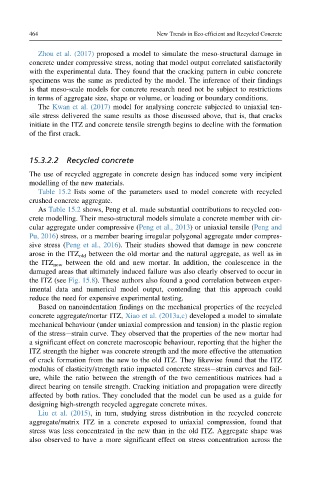Page 515 - New Trends in Eco efficient and Recycled Concrete
P. 515
464 New Trends in Eco-efficient and Recycled Concrete
Zhou et al. (2017) proposed a model to simulate the meso-structural damage in
concrete under compressive stress, noting that model output correlated satisfactorily
with the experimental data. They found that the cracking pattern in cubic concrete
specimens was the same as predicted by the model. The inference of their findings
is that meso-scale models for concrete research need not be subject to restrictions
in terms of aggregate size, shape or volume, or loading or boundary conditions.
The Kwan et al. (2017) model for analysing concrete subjected to uniaxial ten-
sile stress delivered the same results as those discussed above, that is, that cracks
initiate in the ITZ and concrete tensile strength begins to decline with the formation
of the first crack.
15.3.2.2 Recycled concrete
The use of recycled aggregate in concrete design has induced some very incipient
modelling of the new materials.
Table 15.2 lists some of the parameters used to model concrete with recycled
crushed concrete aggregate.
As Table 15.2 shows, Peng et al. made substantial contributions to recycled con-
crete modelling. Their meso-structural models simulate a concrete member with cir-
cular aggregate under compressive (Peng et al., 2013) or uniaxial tensile (Peng and
Pu, 2016) stress, or a member bearing irregular polygonal aggregate under compres-
sive stress (Peng et al., 2016). Their studies showed that damage in new concrete
arose in the ITZ old between the old mortar and the natural aggregate, as well as in
the ITZ new between the old and new mortar. In addition, the coalescence in the
damaged areas that ultimately induced failure was also clearly observed to occur in
the ITZ (see Fig. 15.8). These authors also found a good correlation between exper-
imental data and numerical model output, contending that this approach could
reduce the need for expensive experimental testing.
Based on nanoindentation findings on the mechanical properties of the recycled
concrete aggregate/mortar ITZ, Xiao et al. (2013a,c) developed a model to simulate
mechanical behaviour (under uniaxial compression and tension) in the plastic region
of the stress strain curve. They observed that the properties of the new mortar had
a significant effect on concrete macroscopic behaviour, reporting that the higher the
ITZ strength the higher was concrete strength and the more effective the attenuation
of crack formation from the new to the old ITZ. They likewise found that the ITZ
modulus of elasticity/strength ratio impacted concrete stress strain curves and fail-
ure, while the ratio between the strength of the two cementitious matrices had a
direct bearing on tensile strength. Cracking initiation and propagation were directly
affected by both ratios. They concluded that the model can be used as a guide for
designing high-strength recycled aggregate concrete mixes.
Liu et al. (2015), in turn, studying stress distribution in the recycled concrete
aggregate/matrix ITZ in a concrete exposed to uniaxial compression, found that
stress was less concentrated in the new than in the old ITZ. Aggregate shape was
also observed to have a more significant effect on stress concentration across the

